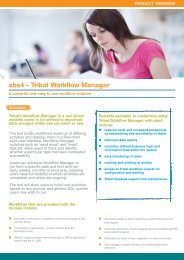Annual Report Accounts 2012 - Tribal
Annual Report Accounts 2012 - Tribal
Annual Report Accounts 2012 - Tribal
You also want an ePaper? Increase the reach of your titles
YUMPU automatically turns print PDFs into web optimized ePapers that Google loves.
66<strong>Tribal</strong> Group plc <strong>Annual</strong> <strong>Report</strong> and <strong>Accounts</strong> <strong>2012</strong> | Notes to the financial statementsNotes to the financial statements continued1. Accounting policies (continued)Business systemsIn accordance with IAS 38, the Group’s business systems are treated as an intangible asset. Costs included are those directlyattributable to the design, construction and testing of new systems (including major enhancements) from the point of inceptionto the point of satisfactory completion, namely where the probable future economic benefits arising from the investment couldbe assessed with reasonable certainty at the time the costs are incurred. Maintenance and minor modifications are expensedagainst the income statement as incurred. These assets are amortised by equal instalments over an average of five years.Internally generated intangible assets – research and development costsExpenditure on research activities is recognised as an expense in the period in which it is incurred.An internally generated intangible asset arising from the Group’s product development is recognised only if all of the followingconditions are met:• an asset is created that can be identified;• it is probable that the asset created will generate future economic benefits; and• the development costs of the asset can be measured reliably.Internally generated intangible assets are amortised on a straight-line basis over their useful lives of three to five years. Whereno internally generated intangible asset can be recognised, development expenditure is recognised as an expense in theperiod in which it is incurred.Property, plant and equipmentProperty, plant and equipment are stated at cost, net of depreciation and any recognised impairment loss. Depreciation ischarged so as to write off the cost of each asset, other than properties in the course of construction, by equal instalments overtheir estimated useful economic lives as follows:• Freehold buildings – over 50 years• Leasehold buildings – life of the lease• Fixtures, fittings and other equipment – 3 to 7 yearsLeasesOperating lease rentals are charged against income on a straight-line basis over the period of the lease. Benefits receivedand receivable as an incentive to enter into an operating lease are spread on a straight-line basis over the lease term. Rentalincome from operating leases is recognised on a straight-line basis over the term of the relevant lease.Borrowing costsBorrowing costs directly attributable to the construction of qualifying assets and long-term contract costs are capitalised aspart of the cost of those assets. The commencement of capitalisation begins when both finance costs and expenditures forthe asset are being incurred and activities that are necessary to get the assets ready for use are in progress. Capitalisationceases when substantially all the activities that are necessary to get the asset ready for use are complete. All other borrowingcosts are recognised in income or expense in the period in which they are incurred.InvestmentsInvestments are initially measured at cost, including transaction costs. Investments are classified as either held-for-trading oravailable-for-sale. They are measured at subsequent reporting dates at cost where they relate to unquoted equity investmentswhere fair value cannot be reliably measured and at fair value otherwise. A provision for any impairment is made where necessary.InventoriesInventories are stated at the lower of cost and net realisable value. Cost comprises materials, direct labour and a share ofproduction overheads appropriate to the relevant stage of production. Net realisable value is based on estimated selling priceless all further costs to completion and all relevant marketing, selling and distribution costs.



